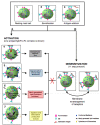Drug Hypersensitivity and Desensitizations: Mechanisms and New Approaches
- PMID: 28632196
- PMCID: PMC5486137
- DOI: 10.3390/ijms18061316
Drug Hypersensitivity and Desensitizations: Mechanisms and New Approaches
Abstract
Drug hypersensitivity reactions (HSRs) are increasing in the 21st Century with the ever expanding availability of new therapeutic agents. Patients with cancer, chronic inflammatory diseases, cystic fibrosis, or diabetes can become allergic to their first line therapy after repeated exposures or through cross reactivity with environmental allergens. Avoidance of the offending allergenic drug may impact disease management, quality of life, and life expectancy. Precision medicine provides new tools for the understanding and management of hypersensitivity reactions (HSRs), as well as a personalized treatment approach for IgE (Immunoglobuline E) and non-IgE mediated HSRs with drug desensitization (DS). DS induces a temporary hyporesponsive state by incremental escalation of sub-optimal doses of the offending drug. In vitro models have shown evidence that IgE desensitization is an antigen-specific process which blocks calcium flux, impacts antigen/IgE/FcεRI complex internalization and prevents the acute and late phase reactions as well as mast cell mediator release. Through a "bench to bedside" approach, in vitro desensitization models help elucidate the molecular pathways involved in DS, providing new insights to improved desensitization protocols for all patients. The aim of this review is to summarize up to date information on the drug HSRs, the IgE mediated mechanisms of desensitization, and their clinical applications.
Keywords: IgE; desensitization; desensitization models; drug hypersensitivity; high affinity IgE Fcε receptor I; mast cells; precision medicine.
Conflict of interest statement
The authors declare no conflict of interest.
Figures





References
-
- Muraro A., Lemanske R.F., Castells M., Torres M.J., Khan D., Simon H.-U., Bindslev-Jensen C., Burks W., Poulsen L.K., Sampson H.A., et al. Precision medicine in allergic disease—Food allergy, drug allergy, and anaphylaxis—PRACTALL document of the European Academy of Allergy and Clinical Immunology and the American Academy of Allergy, Asthma and Immunology. Allergy. 2017;72:1006–1021. doi: 10.1111/all.13132. - DOI - PubMed
-
- Castells M.C., Tennant N.M., Sloane D.E., Ida Hsu F., Barrett N.A., Hong D.I., Laidlaw T.M., Legere H.J., Nallamshetty S.N., Palis R.I., et al. Hypersensitivity reactions to chemotherapy: Outcomes and safety of rapid desensitization in 413 cases. J. Allergy Clin. Immunol. 2008;22:574–580. doi: 10.1016/j.jaci.2008.02.044. - DOI - PubMed
Publication types
MeSH terms
Substances
LinkOut - more resources
Full Text Sources
Other Literature Sources
Medical

